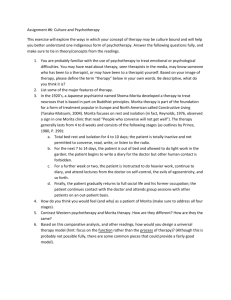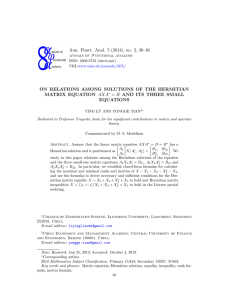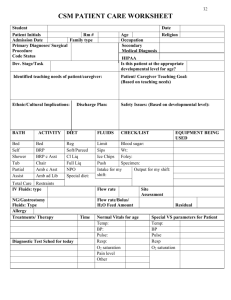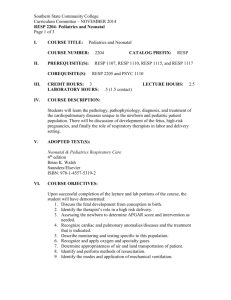The Hermitian Morita Theorems Los Teoremas Herm´ıticos de Morita
advertisement
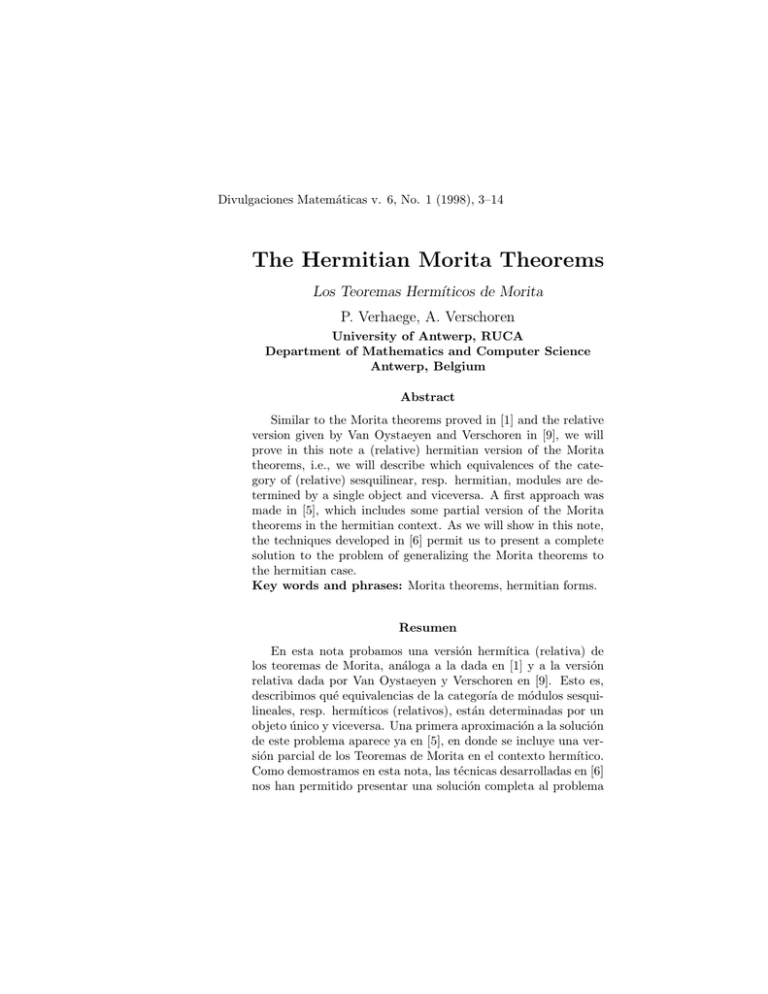
Divulgaciones Matemáticas v. 6, No. 1 (1998), 3–14
The Hermitian Morita Theorems
Los Teoremas Hermı́ticos de Morita
P. Verhaege, A. Verschoren
University of Antwerp, RUCA
Department of Mathematics and Computer Science
Antwerp, Belgium
Abstract
Similar to the Morita theorems proved in [1] and the relative
version given by Van Oystaeyen and Verschoren in [9], we will
prove in this note a (relative) hermitian version of the Morita
theorems, i.e., we will describe which equivalences of the category of (relative) sesquilinear, resp. hermitian, modules are determined by a single object and viceversa. A first approach was
made in [5], which includes some partial version of the Morita
theorems in the hermitian context. As we will show in this note,
the techniques developed in [6] permit us to present a complete
solution to the problem of generalizing the Morita theorems to
the hermitian case.
Key words and phrases: Morita theorems, hermitian forms.
Resumen
En esta nota probamos una versión hermı́tica (relativa) de
los teoremas de Morita, análoga a la dada en [1] y a la versión
relativa dada por Van Oystaeyen y Verschoren en [9]. Esto es,
describimos qué equivalencias de la categorı́a de módulos sesquilineales, resp. hermı́ticos (relativos), están determinadas por un
objeto único y viceversa. Una primera aproximación a la solución
de este problema aparece ya en [5], en donde se incluye una versión parcial de los Teoremas de Morita en el contexto hermı́tico.
Como demostramos en esta nota, las técnicas desarrolladas en [6]
nos han permitido presentar una solución completa al problema
Verhaege, P., Verschoren, A.
4
de la generalización, al contexto hermı́tico, de los Teoremas de
Morita.
Palabras y frases clave: teoremas de Morita, formas hermı́ticas.
1
Generalities.
Throughout this paper, R is a commutative ring with unit and all rings are
unitary R-algebras; the letters A,A0 , . . . , will denote such R-algebras. Let us
denote the category of left (resp. right) A-modules by A-mod (resp. mod-A)
and the corresponding sets of morphisms by A [M, N ] (resp [M, N ]A ). Bimodules will always be defined over R.
An algebra with involution is a couple (A, α), where A is an R-algebra and
α : A → A an R-linear map satisfying α2 = 1A and α(a1 a2 ) = α(a2 )α(a1 ) for
every a1 , a2 ∈ A. We may define with respect to α a construction similar to
the usual “restriction of scalars”. However, since we use an involution instead
of algebra morphisms, we have to switch sides. So, if M is a left (resp. right)
A-module, then α induces a right (resp. left) A-module structure on M by
putting m · a = α(a)m (resp. a · m = mα(a)) for every m ∈ M and a ∈ A.
We denote this module by α M (resp M α ). If (A0 , α0 ) is a second R-algebra
with involution and if M is an (A, A0 )-bimodule then the (A0 , A)-bimodule
α0
M α is defined by putting a0 · m · a = α(a)mα0 (a0 ) for any a ∈ A, a0 ∈ A0
and m ∈ M . If M is an A-bimodule, then we write Mα = α M α .
Any left linear map f ∈ A [M, N ] yields an obvious right linear map
f α ∈ [M α , N α ]A . Actually, (−)α and α (−) define a category equivalence
between A-mod and mod-A.
(1.1) Let us briefly recollect some definitions and properties of abstract localization. For a more detailed treatment, we refer to [2, 3, 4, 7, 8 et al]. We
restrict to left A-modules, right A-modules being treated similarly.
A left exact subfunctor λ of the identity in A-mod such that λ(M/λM ) =
0 for any M ∈ A-mod will be called a radical. Any radical is completely determined by the couple (Tλ , Fλ ), where the torsion class Tλ (resp. the torsionfree
class Fλ )) consists of λ-torsion (resp. λ-torsionfree) left A-modules, i.e. left
A-modules M such that λM = 0 (resp. λM = M ). On the other hand, the
radical λ is also completely determined by the set Lλ of left A-ideals L such
that A/L is λ-torsion. We call this set the Gabriel filter associated to λ. It is
easy to see that m ∈ λM if and only if there exists some L ∈ Lλ such that
Lm = 0.
The Hermitian Morita Theorems
5
A left A-module E is said to be λ-injective, if for any λ-isomorphism f : M →
N in A-mod, i.e., a morphism with both λ-torsion kernel and cokernel, and
any morphism g : M → E there exists a morphism g : N → E extending G,
i.e., with g = g ◦f . If this morphism is always unique as such, then E is said to
be λ-closed. This is also equivalent to E being λ-torsionfree and λ-injective.
The full subcategory of A-mod consisting of the λ-closed left A-modules will
be denoted by (A, λ)-mod and it is well known that the inclusion functor
iλ : (A, λ)-mod ,→ A-mod
possesses an exact adjoint
aλ : A-mod → (A, λ)-mod
(the reflector of A-mod into (A, λ)-mod). The left exact functor
Qλ = iλ ◦ aλ : A-mod → A-mod
is called the localization functor at λ and may be described in many different
ways. For instance let E be an injective hull of M/λM , then Qλ (M ) consists
of those e ∈ E such that Le ⊆ M/λM for some L ∈ Lλ . So, for any left
A-module M , there exists a canonical λ-isomorphism
jλ = jj,M : M → Qλ (M ),
which is the composition of the canonical morphism M → M/λM and the
inclusion M/λM ,→ Qλ (M ). If λ is a radical in A-mod, then Qλ (A) is canonically endowed with an R-algebra structure extending that of A. Moreover,
if M is a left A-module (resp. an (A, A0 )-bimodule) then Qλ (M ) possesses a
natural left Qλ (A)-module (resp. a (Qλ (A), A0 )-bimodule) structure.
(1.2) Let us fix radicals λ and λ0 ) in A-mod and A0 -mod respectively. Then
we say that an (A, A0 )-bimodule P is (λ, λ0 )-flat or relatively flat (with respect
to (λ, λ0 )), if for any left A0 -linear map f 0 : M 0 → N 0 with λ0 -torsion kernel,
the left A-module Ker(P ⊗A0 f 0 ) is λ-torsion. It is easy to see that P is
(λ, λ0 )-flat if and only if Qλ (P ) is relatively flat, or equivalently if it satisfies
each of the following conditions:
(1.2.1) for any injective left A0 -linear map i0 : M 0 ,→ N 0 , the left A-module
Ker(P ⊗A0 i0 ) is λ-torsion.
Verhaege, P., Verschoren, A.
6
(1.2.2) for any λ0 -torsion left A0 -module T 0 , the left A-module P ⊗A0 T 0 is
λ-torsion.
The next (technical) result will play a key-role in all that follows:
(1.3) Lemma. [6,9] Let P be an (A, A0 )-bimodule and M 0 a left A0 -module,
then:
(1.3.1) Qλ(P ⊗A0 M 0 = Qλ(Qλ(P ) ⊗A0 M 0 ;
(1.3.2) if P is relatively flat, then Qλ(P ⊗A0 M 0 = Qλ(P ⊗A0 Qλ0 (M 0 ));
(1.3.3) if P is also relatively flat and λ-closed, then it has a canonical (Qλ (A),
Qλ0 (A0 ))-bimodule structure and for any left Qλ0 (A0 )-module M 0 , the left Amodules P ⊗A0 M 0 , P ⊗Qλ0 (A0 ) M 0 and P ⊗Qλ0 (A0 ) Qλ0 (M 0 ) sre λ-isomorphic.
Let M be an (A, A0 )-bimodule, M ” a left A0 -module, then we will write
b
b A0 m0 for jλ (m ⊗
b A0 m0 ) for any m ∈ M
M ⊗A0 M 0 for Qλ (M ⊗A0 M 0 ) and m ⊗
0
0
0
0
b
0
0
and m ∈ M , where jλ : M ⊗A M → M ⊗A M is the canonical localization
map. So, the previous lemma allows us to write:
b A0 M 0 ⊗
b A0 M 0 ) ⊗
b A00 M 00 = P ⊗
b A0 (M 0 ⊗
b A00 M 00 = (P ⊗
b A00 M 00 )
P⊗
whenever P is relatively flat.
(1.4) A λ-closed and (λ, λ0 )-flat (A, A0 )-bimodule P is said to be (λ, λ0 )invertible or relatively invertible (with respect to (λ, λ0 )) , if there exists a
λ0 -closed and (λ0 , λ)-flat (A0 , A)-bimodule Q together with A-bimodule (resp.
A-bimodule) isomorphisms
b A0 Q → Qλ (A)
ϕ:P⊗
resp. ψ : Q ⊗A P → Qλ0 (A0 ).
Moreover, cf. [9], we may always assume the above isomorphisms to fit into
the following commutative diagrams:
bA P
b A0 Q ⊗
P⊗
b A0 ψ
P⊗
/
b A0 Qλ0 (A0 )
P⊗
b AP
ϕ⊗
bA P ⊗
b A0 Q
Q⊗
resp.
b AP
Qλ (A) ⊗
b Aϕ
Q⊗
/
b A Qλ (A)
Q⊗
b A0 Q
ψ⊗
/
P
b A0 Q
Qλ0 (A0 ) ⊗
/
Q
The Hermitian Morita Theorems
7
The module Q, which is obviously relatively invertible, is said to be an
inverse for P , and is, as one easily verifies, isomorphic to A [P, Qλ (A)]. Moreb A0 (A [P, Qλ (A)]) :→ Qλ (A), may then be used
over, the evaluation map P ⊗
as an isomorphism.
This leads us to the relative version of the Morita theorems, cf. [9]:
(1.5) Theorem. Let λ (resp. λ0 ) be a radical in A-mod (resp. A0 -mod).
Then there is a bijective correspondence between bimodule isomorphism classes
of relatively invertible (A, A0 )-bimodules and isomorphism classes of category
equivalences between the categories (A, λ)-mod and (A0 , λ0 )-mod.
Note that the above correspondence is given by associating to any category
equivalence F : (A, λ)-mod → (A0 , λ0 )-mod , the (λ0 , λ)-invertible (A, A0 )bimodule F (Qλ (A)). Conversely, to any relatively invertible (A, A0 )-bimodule
Q with inverse P , we associate the category equivalence
b A− ∼
Q⊗
= A [P, −] : (A, λ)-mod → (A0 , λ0 )-mod.
Let as point out that Qλ0 (A0 ) and A [P, P ] are isomorphic as left A0 -bimodules.
(1.6) If λ is a radical in A-mod and α : A → A an R-involution, then one
easily verifies the set {α(L) : L ∈ Lλ } to be a Gabriel filter of right A-ideals.
We will write α(λ) for the associated radical (in mod-A) and Qα(λ) for the
localization functor at α(λ) in mod-A. The functors (−)α and α (−) define a
category equivalence between the categories (A, λ)-mod and mod-(A, α(λ)).
Moreover, for any left A-module M , we have Qλ (M )α = Qαλ (M α ) and if
0
0
M is an (A, A0 )-bimodule, then α Qλ (M )α = Qαλ (α M α ), where α0 is an
R-involution on A0 . In particular, if M is an A-bimodule, then Qλ (M )α =
Qαλ (Mα ).
(1.7) A triple (A, α, λ) is called a torsion triple, if (A, α) is an R-algebra with
involution and λ a radical in A-mod which satisfies the equivalent conditions:
(1.7.1) the R-involution α : A → A extends (uniquely) to an R-involution
α
b : Qλ (A) → Qλ(A);
(1.7.2) the R-algebras Qλ (A) and Qα(λ) (A) are isomorphic over A;
(1.7.3) there exists a (λ, λ0 )-invertible (A, A0 )-bimodule P , for some algebra
with involution (A0 , α0 ) and radical λ0 in A0 -mod], with the property that
Verhaege, P., Verschoren, A.
8
α0
P ∼
as (A, A0 )-bimodules.
=α
A [P, Qλ (A)]
Note that these conditions are trivially fulfilled whenever λ is induced by
a radical in R-mod; for other examples we refer to [6,10].
2
Hermitically invertible modules.
(2.1) Let us fix a torsion triple (A, α, λ) and a λ-closed left A-module M . A
map h : M × M → Qλ (A) which is biadditive and satisfies h(a1 m1 , a2 m2 ) =
a1 h(m1 , m2 )α(a2 ) for every a1 , a2 ∈ A and m1 , m2 ∈ M is called a λ-sesquilinear form. If, moreover, h(m1 , m2 ) = α
b(h(m2 , m1 )), then h is called a
λ-hermitian form. For any λ-sesquilinear form h : M × M → Qλ (A), define
a
ha ∈ A [M,α
A [M, Qλ (A)]] by h (m2 )(m1 ) = h(m1 , m2 ) for any m1 , m2 ∈ M .
This correspondence defines a bijection between the λ-sesquilinear forms on M
a
and the left A-linear maps from M to α
A [M, Qλ (A)]. If h is an isomorphism,
0
then h is called nonsingular. If M is an (A, A )-bimodule and h : M × M →
Qλ (A) a λ-sesquilinear form satisfying h(m1 a0 , m2 ) = h(m1 , m2 α0 (a0 )), for
any a0 ∈ A0 and m1 , m2 ∈ M then h is said to be A0 -compatible. So, an
A0 -compatible λ-sesquilinear morphism h : M × M → Qλ (A) is essentially a
0
b A0 α M α → Qλ (A). Note also that this is equivalent
bimodule morphism M ⊗
α0
to requiring that the map ha : M → α
is (A, A0 )-linear.
A [M, Qλ (A)]
If M is a λ-closed left A-module and h : M × M → Qλ (A) a λ-sesquilinear
form, then the couple (M, h) is called a λ-sesquilinear module or a relative
sesquilinear module. If h is also λ=hermitian, then (M, h) is a λ-hermitian
module or relative hermitian module. It is said to be A0 -compatible (resp. nonsingular) whenever h is A0 -compatible (resp. nonsingular).
(2.2) A morphism f : (M, h) → (N, k) between λ-sesquilinear left A-modules
is a left A-linear map f : M → N such that h = k ◦ (f × f ), or, equivalently
such that the diagram
M
ha
α [M, Q (A)]
λ
A
/
O
α
A [f,Qλ (A)]
f
N
ka
/
α
A [N, Qλ (A)]
commutes. We thus obtain categories S(A, α, λ), resp. H(A, α, λ), with objects the λ-sesquilinear left A-modules, resp. λ-hermitian left A-modules, and
with obvious morphisms.
The Hermitian Morita Theorems
9
(2.3) Fix some torsion triples (A, αλ) and (A, α0 , λ0 ). A nonsingular λhermitian (A, A0 )-bimodule (P, h) is called hermitically (λ, λ0 )-invertible or relatively hermitically invertible, if P is (λ, λ0 )-invertible and h is A0 -compatible.
As one easily verifies, h is then also Qλ0 (A0 )-compatible.
As an easy example, let pQλ (A) : Qλ (A) × Qλ (A) → Qλ (A) be defined by
pQλ (A) (a1 , a2 ) = a1 α
b(a2 ),
for any a1 , a2 ∈ Qλ (A). Then (Qλ (A), pQλ (A) ) is a hermitically (λ, λ0 )invertible A-bimodule.
If (P, h) is a relatively hermitically invertible (A, A0 )-bimodule, then we
can make Q = A [P, Qλ (A)] into a hermitically (λ0 , λ)-invertible (A0 , A)-bimodule by endowing it with the form k : Q × Q → Qλ0 (A0 ) ∼
= A [P, P ], defined by
putting for any q1 , q2 ∈ Q:
k(q1 , q2 ) : P → P : p 7→ k(q1 , q2 )(p) = h(p, (ha )−1 (q1 ))(ha )−1 (q2 ).
The module (Q, k) is usually referred to as an “inverse” of (P, h).
(2.4) Let (M, h) be a relatively flat A0 -compatible λ-sesquilinear (resp. λhermitian) (A, A0 )-bimodule and (M 0 , h0 ) a λ-sesquilinear (resp. λ-hermitian)
left A0 -module. Then we may define a λ-sesquilinear (resp. λ-hermitian) form
h ⊗A0 h0 : M ⊗A0 M 0 × M ⊗A0 M 0 → Qλ (A)
by
h ⊗A0 h0 (m1 ⊗A0 m01 , m2 ⊗A0 m02 ) =
=
h(m1 h0 (m01 , m02 ), m2 )
h(m1 , m2 h0 (m01 , m02 )),
for any m1 , m2 ∈ M and m01 , m02 ∈ M 0 . One easily verifies the tensor product
thus defined to be associative, and the form h ⊗A0 h0 to be A00 -compatible,
whenever (M 0 , h0 ) is.
b A0 M 0 × M ⊗
b A0 M 0 → Qλ (A)
Since Qλ (A) is α(λ)-closed and since jλ : M ⊗
0
is a λ-isomorphism, the form h ⊗A0 h defines a unique λ-sesquilinear (resp.
b A0 M 0 × M ⊗
b A0 M 0 → Qλ (A) making the
b A0 h 0 : M ⊗
λ-hermitian) form h ⊗
diagram
Verhaege, P., Verschoren, A.
10
b A0 M 0 × M ⊗
b A0 M 0
M⊗
UUUU
UUUhU⊗A0 h0
UUUU
UUUU
UU
jλ ×jλ
i Qλ (A)
iiii
i
i
i
ii
iiiib A0 h0
iiii h ⊗
b A0 M 0 × M ⊗
b A0 M 0
M⊗
*
4
commutative, cf. [5]. It thus makes sense to define the relative tensor product
b A0 (M 0 , h0 ) to be the λ-sesquilinear (resp. λ-hermitian) left A-module
(M, h) ⊗
b
b A0 h0 ). An easy unicity argument shows this tensor product to
(M ⊗A0 M 0 , h ⊗
be associative, whenever it is defined.
3
Morita theorems.
(3.1) Fix torsion triples (A, α, λ) and (A0 , α0 , λ0 ). Recall from [5,6] that any
relatively hermitically invertible (A, A0 )-bimodule (P, h) determines an equivalence of categories
b A0 − : S(A0 , α0 , λ0 ) → S(A, α, λ)
(P, h) ⊗
and an equivalence
b A0 − : H(A0 , α0 , λ0 ) → H(A, α, λ)
(P, h) ⊗
Moreover, if (Q, k) is as in (2.3), then
b A − : S(A, α, λ) → S(A0 , α0 , λ0 )
(Q, k) ⊗
resp.
b A − : H(A, α, λ) → H(A0 , α0 , λ0 )
(Q, k) ⊗
b A0 −.
is an inverse for (P, h) ⊗
(3.2) In order to establish the complete Morita theorems, we need a notion of
“good” category equivalence between categories of relative sesquilinear (resp.
relative hermitian) modules: a category equivalence
F : S(A, α, λ) → S(A0 , α0 , λ0 )
The Hermitian Morita Theorems
11
resp.
F : H(A, α, λ) → H(A0 , α0 , λ0 )
is said to be decent, if it factorizes through a category equivalence
F : (A, λ)-mod → (A0 , λ0 )-mod
note that we use the same simbol F , as no ambiguity may arise) i.e., if we
have a commutative diagram of functors
F
S(A, α, λ)
/
(A, λ)-mod
F
S(A0 , α0 , λ0 )
/
(A0 , λ0 )-mod
where the vertical arrows are defined by forgetting the relative sesquilinear
form (a similar condition holds for the category of relative hermitian modules)
0
∼ α0
and if there exists an isomorphism η : F (α
A [(−), Qλ (A)]) = A0 [F (−), Qλ0 (A )]
such that for every λ-sesquilinear left A-module (M, l), we have a commutative
diagram
pp
ppp
p
p
p
ppp
α
F (A [M, Qλ (A)])
F (M )
F (la )
w
ηM
OOO
OOFO (l)a
OOO
OO
α0
0
A0 [F (M ), Qλ0 (A )]
'
/
If (M, l) is a λ-sesquilinear (A, A00 )-bimodule, then, by the naturality of
η, we have that ηM is an (A0 , A00 )-bimodule isomorphism. Moreover, we will
only consider category equivalences between relatively sesquilinear modules
which map relative hermitian modules to relative hermitian modules.
We will prove below that if G is an inverse for F , then G is decent as well.
Before we can show that the category equivalence induced by a relatively
hermitically invertible bimodule is decent, we need the following lemma, whose
proof is just a straightforward verification.
(3.3) Lemma. Let U be a right A0 -module, V a left A-module and W an
(A, A0 )-bimodule, then the morphism
µ : [U,A [V, W ]]A0 → A [V, [U, W ]A0 ]
defined by (µ(f )(v))(u) = f (u)(v), for every f ∈ [U,A [V, W ]]A0 , u ∈ U and
v ∈ V , is an isomorphism. If V is an (A, A00 )-bimodule, then µ is left A00 -
Verhaege, P., Verschoren, A.
12
linear and if U is an (A00 , A0 )-bimodule, then µ is right A00 -linear.
(3.4) Proposition (Morita I). Fix torsion triples (A, α, λ) and (A0 , α0 , λ0 ).
Then any relatively hermitically invertible (A0 , A)-bimodule (Q, k) defines a
decent equivalence between the categories S(A, α, λ) and mathhcalS(A0 , α0 , λ0 )
and the categories H(A, α, λ) and mathcalH(A0 , α0 , λ0 ).
Proof. Let (P, h) be an inverse for (Q, k). Define for every λ-closed left
A-module M the isomorphism ηM as the composition of the following isomorphisms
b Aα
Q⊗
A [M, Qλ (A)]
α
∼
∼
= A [P, α
A [M, Qλ (A)]] = A [P, [M , Qλ (A)α ]A ]
∼
= [M α , A [P, Qλ (A)]]A
= [M α , A [P, Qλ (A)α ]]A ∼
0
∼
= [M α , Q]A ∼
= α [M, P ]
∼
=
α0
b
A0 [Q ⊗A
A
0
0
bA P] ∼
b
M, Q ⊗
=α
A0 [Q ⊗A M, Qλ0 (A )].
An easy verification shows that
b A f )(q 0 ⊗
b A m0 ) = k(q 0 f (m0 ), q)
ηM (q ⊗
∼
b Aα
and that η : Q ⊗
A [(−), Qλ (A)] =
M and q ∈ Q, we have that
α0
b
A0 [Q ⊗A
(−), Qλ0 (A0 )]. So, for every m ∈
b A la (m)) = (k ⊗
b A l)a (q ⊗
b A m),
ηM (q ⊗
b A0 − is decent as well.
b A − is decent. By symmetry, P ⊗
i.e., (Q, k)⊗
2
Conversely,
(3.5) Proposition (Morita II). Let (A, α, λ) and (A0 , α0 , λ0 ) be torsion
triples. Then every decent category equivalence between S(A, α, λ) and S(A0 ,
α0 , λ0 ) (resp. H(A, α, λ) and mathcalH(A0 , α0 , λ0 )) is induced by a relatively
hermitically invertible (A0 , A)-bimodule.
Proof. Let F : H(A, α, λ) → H(A0 , α0 , λ0 ) be a decent category equivalence,
then (Q, k) = F (Qλ (A), pQλ (A) ) is a hermitically (λ0 , λ)-invertible (A0 , A)b A −.
bimodule. Let us now show that F (−) = (Q, k)⊗
0
0
b
As F = Q ⊗A − : (A, λ)-mod → (A , λ )-mod, we only have to verify
b A l, for every λ-sesquilinear left A-module (M, l). Let
that F (l) = k ⊗
∼
0
α
0
η : F (α
A [(−), Qλ (A)]) → A0 [F (−), Qλ0 (A )],
The Hermitian Morita Theorems
13
then
0
0
ηQλ (A) = k a : Q → α
A0 [Q, Qλ0 (A )].
Let (M, l) be a λ-sesquilinear left A-module, then for every m ∈ M we have
a commutative diagram
Q
b A αA [la (M),Qλ (A)]
Q⊗
/
b Aα
Q⊗
A [M, Qλ (A)]
ηM
ka
α0
0
b
A0 [Q⊗A , Qλ0 (A )]
/
b
α0
[Q⊗A la (m),Qλ0 (A0 )]
A0
α0
0
b
A0 [Q⊗A M, Qλ0 (A )]
after identifying
b Aα
Q = Q⊗
A [Qλ (A), Qλ (A)]
and
α0
0
b
A0 [Q⊗A , Qλ0 (A )]
0
0
b
=α
A0 [Q⊗A Qλ (A), Qλ0 (A )].
b A la ), we have for every q, q 0 ∈ Q and m, m0 ∈ M
So, since F (l)a = ηM ◦ (Q ⊗
b A m))(q 0 ⊗
b A m0 )
(F (l)a (q ⊗
b A la ))(q ⊗
b A m))(q 0 ⊗
b A m0 )
= ((ηM ◦ (Q ⊗
a
0
0
b A l (m))(q ⊗
bA m )
= ηM (q ⊗
α
a
b A A [l (m), Qλ (A)]))(q))(q 0 ⊗
b A m0 )
= ((ηM ◦ (Q ⊗
0
0
a
0 b
0
b a
= ((α
A0 [Q ⊗A l (m), Qλ0 (A )] ◦ k )(q))(q ⊗A m )
b A la (m))))(q 0 ⊗
b A m0 )
= (k a (q) ◦ (Q ⊗
= k a (q)(q 0 l(m0 , m))
b A m))(q 0 ⊗
b A m0 ),
b A l)a (q ⊗
= ((k ⊗
b A l, as claimed.
hence F (l) = k ⊗
2
(3.6) Corollary. With the same notations, if G is an inverse for F , then
b A0 −, where (P, h) is an inverse for (Q, k).
G = (P, h) ⊗
In particular, G is also decent, as claimed before.
References
[1] Bass, H., The Morita Theorems, University of Oregon, Lecture Notes,
Benjamin, 1968.
14
Verhaege, P., Verschoren, A.
[2] Gabriel, P., Des Catégories Abeliannes, Bull. Soc. Math. France, 90
(1962), 323–448.
[3] Golan, J. Localization in Noncommutative Rings, M. Dekker, New York,
1975.
[4] Goldman, J. Rings and Modules of Quotients, J. Algebra, 13 (1969),
10–49.
[5] Marquez Hernandez, C. M., Reyes Sanchez, M. V., Verschoren, A. Relatively Hermitian Morita Theory, Part I: Morita Equivalences of Algebras
with Involution, J. Algebra, 162 (1993), 146–147.
[6] Reyes S., M. V., Verhaeghe, P., Verschoren, A. The Relatively Hermitian
Picard Group, Comm. Algebra, 23 (1995), 3915–3941.
[7] Stenström, B. Rings of Quotients, Springer-Verlag, Berlin, 1975.
[8] Van Oystaeyen, F., Verschoren, A. Reflectors and Localizations, M.
Dekker, New York, 1979.
[9] Van Oystaeyen, F., Verschoren, A. Relative Invariants of Rings: The
Noncommutative Theory, M. Dekker, New York, 1984.
[10] Verhaeghe, P., Hermitian Morita Theory, Ph.D. Thesis, University of
Antwerp, 1996.

